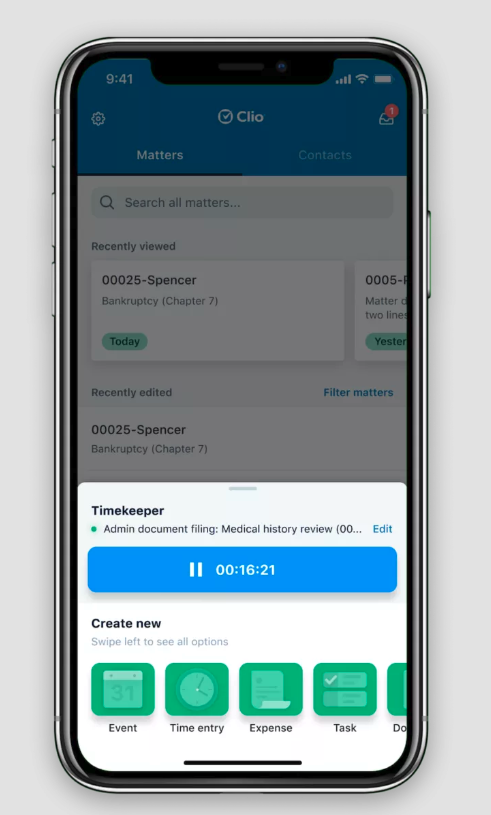Understanding how to calculate utilisation rate is integral to running a successful law firm business. Law firms are also unique when compared to other businesses because hours are divided into billable versus non-billable. According to the Legal Trends Report, your firm’s utilisation rate allows you to measure your firm’s workload and productivity. It’s one of the most important KPIs law firms should track.
Read on to learn how to calculate and increase your firm’s utilisation rate and how to use that information to help your law firm succeed.
The utilisation rate is calculated as the percentage of an employee's total working hours that are spent productively, specifically the hours billable to a client. Essentially, the utilisation rate quantifies the proportion of an employee's total working hours dedicated to productive tasks for clients.
How to calculate utilisation rate?
Why are utilisation rates important for law firms?
Knowing how to calculate utilisation rates is critical for law firms. When you know how to calculate utilisation rate for your law firm, that knowledge can provide insight into your firm’s billing efficiency. While knowing how to calculate utilisation rate is important, you should also keep in mind these other key law firm KPIs:
- Utilisation rate: As stated above, the utilisation rate measures workload and productivity. You can calculate the utilisation rate by dividing billable hours worked by the number of hours worked in a day.
- Realisation rate: This measures the potential value of work performed. You can determine your law firm’s realisation rate by dividing the number of billable hours invoiced by the number of hours worked.
- Collection rate: This rate measures the ability to capitalise on work performed. You can determine this by dividing the number of hours collected by the number of hours invoiced.
What is the formula for calculating utilisation rate?
The formula for calculating your law firm’s utilisation rate is to divide the number of billable hours worked by the number of worked hours in a day. For example, if your law firm has a 31% utilisation rate, your firm secured 2.5 billable hours in an eight-hour working day.
How to calculate utilisation rate
We know you can calculate your firm’s utilisation rate by dividing the number of billable hours worked by the number of total hours worked. Let’s take a look at some examples using this formula:
- Catherine worked 60 hours last week. Out of those hours, 20 were billable. If we divide 20 by 60 and then multiply by 100, we get 33.33. Therefore, Catherine’s utilisation rate for that one week is 33.33%.
- Avery had a 12-hour workday. They billed five of those hours to clients. Using the same equation above, we can determine Avery’s utilisation rate for the day—41.67%.
It’s important to remember that your (or your law firm’s) utilisation rate doesn’t determine a solicitor’s value. KPIs are metrics we can use to quantify certain operations to improve your firm’s success. Lawyers are humans helping other humans, and numbers only tell us part of that story. A revenue-related KPI won’t quantify client happiness or help you determine if you’re providing a client-centred experience. KPIs are one of the tools you should use when evaluating the operations of your firm.
You may like these posts
How can you use utilisation rates for your law firm?
Calculating utilisation rates gives lawyers the important data and insights they need to make informed business decisions. For example, you can use utilisation rates to better understand the profitability potential for different legal services.
Utilisation rates can also provide insight into resource allocation. For example, if a lawyer’s utilisation rate is quite high, they might need more resources and support.
What is the average utilisation rate for law firms?
According to the 2022 Legal Trends Report, law firms saw a big jump in utilisation rates from 2021 to 2022—from 31% to 33%.
But the 2022 Legal Trends Report also shows that the average lawyer collects only £748 for every £1,000 of billable work. This means that law firms could collect up to 34% more revenue by optimizing their realisation and collection rates. Keep in mind that average rates might vary based on practice area, geographical location, and how many years of experience a lawyer has. You can get a better sense of industry standards by reviewing average industry utilisation rates.
According to the 2021 Legal Trends Report, on average, full-time lawyers work 49.6 hours each week. Of course, this number will vary and in this context, we’re using it as a starting point for comparison. As for the number of billable hours lawyers work per year, this too will vary. Legal business consultants suggest that 1650 billable hours is a realistic goal for smaller firms. If we take 1650 billable hours and divide this by 50 weeks (assuming solicitors take two weeks of vacation), we get 33 billable hours per week. Now, we can divide this by the 49.6 figure mentioned above (average hours worked per week) and we get an average utilisation rate of 66%—more than double the industry average in 2019.
So, how can lawyers close the gap between 33% and 66%? Below we outline the process to increase your firm’s utilisation rate.
How to increase your law firm’s utilisation rate
Track your firm’s utilisation rate
What gets measured, gets managed. Now that you know how to calculate utilisation rate, you need to determine what your firm’s utilisation rate is. Then, set a calendar reminder to record it regularly. This might be weekly, bi-weekly, or monthly depending on your goals.
Have a clear, realistic goal
If your goal is to have a utilisation rate of 45% in January, record this and set your tracking notifications accordingly. Planning backwards from your benchmark goal enables you to be clear on what you’re working towards and stay accountable.
Track time
Time recording and calculating law firm KPIs go hand in hand. Tracking time doesn’t have to be complicated or laborious. Once you understand how to track utilisation rates and the importance of it, it’s evident why you should prioritise time recording.

Automate your law firm with cloud-based legal practice management software
It’s never been easier to automate non-billable, administrative tasks. Automation simply means you can reduce the amount of time you spend on non-billable work. With automation, you can free up your time to take on more billable, client-centred work.
Delegate and do less non-billable work
Delegation isn’t easy, but it certainly is necessary. The high-growth and tech-centric accounting firm, Envolta, listed “learning to delegate” as one of the five hardest things you’ll have to face as a business owner. Not even the best solicitors can do everything themselves. On the contrary, the best lawyers succeed largely thanks to their ability to delegate. With the right legal practice management software, assigning tasks (from a workflow perspective) is a lot easier.
Optimise your law firm’s workflows and processes
Streamlining processes from client intake to billing will have profound effects on your firm’s workflow. Moreover, optimisation should enable you to take on more billable hours, therefore supporting your utilisation rate goals.
As for law firm collections, how do you optimise the process for your firm? Using modern and flexible payment solutions can help you streamline the payment process and get paid faster.
Learn more about how you can improve your collection rates, streamline your payment process, and make it easy for your clients to pay with Clio Payments.
Your utilisation rate is one of the keys to your law firm’s success
By accurately recording your time, you can be confident when calculating your firm’s utilisation rate. The more you track your efforts, the easier it will be to identify challenges, solutions, and improvements.
Using an all-in-one practice management software with time tracking and reporting capabilities will help you measure your utilisation rate. And ultimately, work towards tracking progress and growing this number, all while prioritizing the client-centred experience.
Read our Guide: How to Improve Payment Collections in Your Law Firm
We published this blog post in May 2024. Last updated: .
Categorized in: Business







